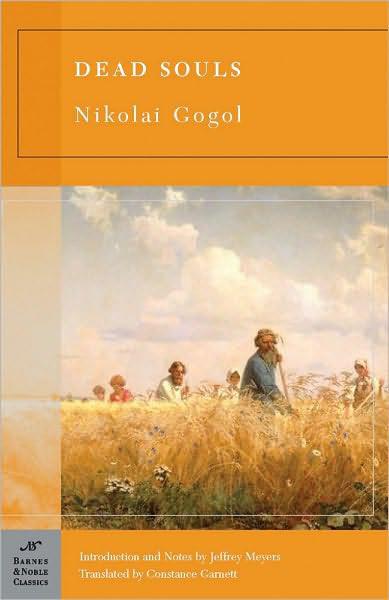
Dead Souls (B&N) PDF
Preview Dead Souls (B&N)
Dead Souls, by Nikolai Gogol, is part of the *Barnes & Noble Classics *series, which offers quality editions at affordable prices to the student and the general reader, including new scholarship, thoughtful design, and pages of carefully crafted extras. Here are some of the remarkable features of Barnes & Noble Classics:
- All editions are beautifully designed and are printed to superior specifications; some include illustrations of historical interest. Barnes & Noble Classics pulls together a constellation of influences—biographical, historical, and literary—to enrich each reader's understanding of these enduring works.
Russia’s first major novel, and perhaps still its most popular, Nikolai Gogol’s Dead Souls is a comic epic of greed and gluttony that is admired not only for its colorful cast of characters and devastating satire, but also for its sense of moral fervor.
The anti-hero of the novel is a man named Chichikov, who hatches a brilliant plan to get rich quick. He will journey through Russia and buy up, at reduced rates, the recently deceased serfs of landowners, who now won’t have to pay government taxes on the ‘dead souls.’ With this list of fictitious serfs as collateral, Chichikov can buy an estate and begin amassing his fortune. What follows is a series of grotesquely humorous transactions with Russian landowners, each more queer and repellant than the last. Although Gogol spends much of the novel exposing the evils of the Russian gentry through absurd and hilarious satire, he also expresses a passionate love for his country that resonates with readers even today.
A stylistic tour de force, encompassing an astonishing range of voices from delicate, intimate lyricism to robust, bawdy ribaldry, Dead Souls is an intensely felt anatomy of the human condition.
Jeffrey Meyers, a Fellow of the Royal Society of Literature, has published forty-three books, including biographies of Ernest Hemingway, Robert Frost, D. H. Lawrence, Joseph Conrad, and George Orwell. He also wrote the Introductions and Notes to the Barnes & Noble Classics editions of Edith Wharton’s The House of Mirth and Rudyard Kipling’s Kim.
Excerpt. © Reprinted by permission. All rights reserved.*From Jeffrey Meyers’s Introduction to Dead Souls
*
Like Edgar Allan Poe, born the same year, Gogol suffered from poverty and had grandiose literary ambitions. They came from different countries, had different languages and cultures, and probably never heard of each other, but they were surprisingly similar. Like Poe, Gogol moved restlessly from place to place, shamelessly sponged off family and friends, read his works aloud with dramatic effect, used several pseudonyms (including the cryptic “0000”), was interested in fashionable clothing and interior décor, allowed cats to play intriguing parts in his tales, failed to finish major projects, poached from obscure sources, claimed knowledge he didn’t have, suffered delusions of grandeur, and was driven by suicidal impulses. Poe drank himself to death; Gogol starved himself to death.
Like Poe, Gogol was strongly influenced by the German writer E. T. A. Hoffmann, who depicted pathological states and criminal impulses, and created a disturbing atmosphere by combining factual reality with grotesque fantasies. Both Poe and Gogol had a strong element of sadomasochism in their lives and their imaginations, and wrote tortuous and often outrageous books with “Arabesque” in the titles. They had a haunted, hallucinatory vision, with idealized dead women rising from the grave to harm the living and the Devil himself making a menacing appearance. Both used caricature and melodrama, emphasized the eccentric and bizarre aspects of human experience, and portrayed the lower depths of society. Both described incest and violent retribution, the nightmare of urban isolation, the power of the supernatural, and the horrific as well as the precarious instability, psychological disintegration, and mental collapse of their self-destructive heroes. Gogol’s tale “The Diary of a Madman” describes the sort of unbalanced first-person narrator who appears in many of Poe’s stories.
Gogol’s appearance and character matched his weird behavior. An actor portrayed him as both foppish and slovenly: “Of medium height, blond, with a huge wig, wearing gold-rimmed spectacles on his long, birdlike nose, with squinting little eyes, and firmly compressed, as if bit-together, lips.” Turgenev, who hadn’t seen Gogol for fifteen years, met him in Moscow in 1851 and, with a novelist’s eye, deduced his character from his unattractive, vulpine (rather than birdlike) appearance:
His fair hair, which fell straight from the temples, as is usual with Cossacks, still preserved its youthful tint, but had thinned noticeably; his smooth, retreating white forehead conveyed, as before, the impression of great intelligence. His small brown eyes sparkled with gaiety at times—yes, gaiety and not sarcasm; but mostly they looked tired. Gogol’s long, pointed nose gave his face a sort of cunning, fox-like expression; his puffy, soft lips under the clipped moustache also produced an unfavourable impression; in their indefinite contours—so at least it seemed to me—the dark sides of his character found expression. When he spoke, they opened unpleasantly, showing a row of bad teeth. His small chin disappeared into his wide, black velvet cravat.
Another friend, who unexpectedly called on Gogol when he was writing, was astonished by his exotic, theatrical dress: “Before me stood Gogol in the following fantastic get-up: in place of boots—long Russian woolen stockings, which reached above the knee; instead of a jacket—a velvet spencer [short, double-breasted overcoat] over a flannel camisole, with a large, bright-colored scarf wrapped around his neck and a raspberry-colored, velvet kokoshnik, embroidered in gold, on his head, quite similar to the headdress of Finnish tribeswomen.”
